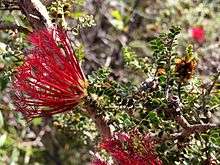Beaufortia elegans
Beaufortia elegans, commonly known as elegant beaufortia is a plant in the myrtle family, Myrtaceae and is endemic to the south-west of Western Australia. It is an erect, diffuse shrub with crowded, curved leaves and heads of flowers that are usually reddish purple, although other colours also occur.
| Elegant beaufortia | |
|---|---|
 | |
| Beaufortia elegans in the Stirling Range National Park | |
| Scientific classification | |
| Kingdom: | Plantae |
| Clade: | Tracheophytes |
| Clade: | Angiosperms |
| Clade: | Eudicots |
| Clade: | Rosids |
| Order: | Myrtales |
| Family: | Myrtaceae |
| Genus: | Beaufortia |
| Species: | B. elegans |
| Binomial name | |
| Beaufortia elegans | |
| Subspecies | |
|
Beaufortia elegans var. minor Benth., 1867[2] | |
| Synonyms | |
|
Melaleuca scitula Craven & R.D.Edwards | |
Description
Beaufortia elegans is an erect, usually spreading shrub which grows to a height of 2.5 metres (8 ft). The leaves are arranged in opposite pairs and are 2–5 millimetres (0.08–0.2 in) long, crowded, dished, curved and lacking a stalk.[3][4]
The flowers are usually red to dark purplish red but other colours and white flowers are sometimes seen. They are arranged in heads about 20 millimetres (0.8 in) in diameter, on the ends of branches which continue to grow after flowering. The flowers have 5 sepals, 5 petals and 5 bundles of stamens. Each bundle contains 4 to 7 stamens joined for about 3–4 millimetres (0.1–0.2 in) long of their length with the free parts a further 4–6 millimetres (0.2–0.2 in) long. Flowering occurs from June to January but mostly from October to December and is followed by fruits which are woody, almost spherical capsules 8–10 millimetres (0.3–0.4 in) in diameter.[3][4][5]
Taxonomy and naming
Beaufortia elegans was first formally described in 1843 by Johannes Conrad Schauer in Dissertatio phytographica de Regelia, Beaufortia et Calothamno.[6] The specific epithet (elegans) is a Latin word meaning "fine", "choice" or "tasteful".[7]
Distribution and habitat
Beaufortia elegans mainly occurs between Perth and Geraldton in the Avon Wheatbelt, Geraldton Sandplains, Jarrah Forest and Swan Coastal Plain biogeographic regions.[3] It usually grows in sand in kwongan vegetation often over laterite on plains and in areas that are wet in winter.[8]
Conservation
Beaufortia elegans is classified as "not threatened" by the Western Australian Government Department of Parks and Wildlife.[3]
References
- Schauer Nova Acta Phys.-Med. Acad. Caes. Leop.-Carol. Nat. Cur. 21: 16 1844
- Benth. Fl. Austral. 3: 169 1867
- "Beaufortia elegans". FloraBase. Retrieved 20 August 2015.
- Corrick, Margaret G.; Fuhrer, Bruce A. (2009). Wildflowers of southern Western Australia (3rd ed.). Kenthurst, N.S.W.: Rosenberg Publishing. p. 112. ISBN 9781877058844. Retrieved 20 August 2015.
- Burbidge, Andrew A. (2016). "A taxonomic revision of Beaufortia (Myrtaceae: Melaleuceae)". Nuytsia. 27: 181–182.
- "Beaufortia elegans". APNI. Retrieved 20 August 2015.
- Brown, Roland Wilbur (1956). The Composition of Scientific Words. Washington, D.C.: Smithsonian Institution Press. p. 131.
- Paczkowska, Grazyna; Chapman, Alex R. (2000). The Western Australian flora : a descriptive catalogue. Perth: Wildflower Society of Western Australia. p. 349. ISBN 0646402439.